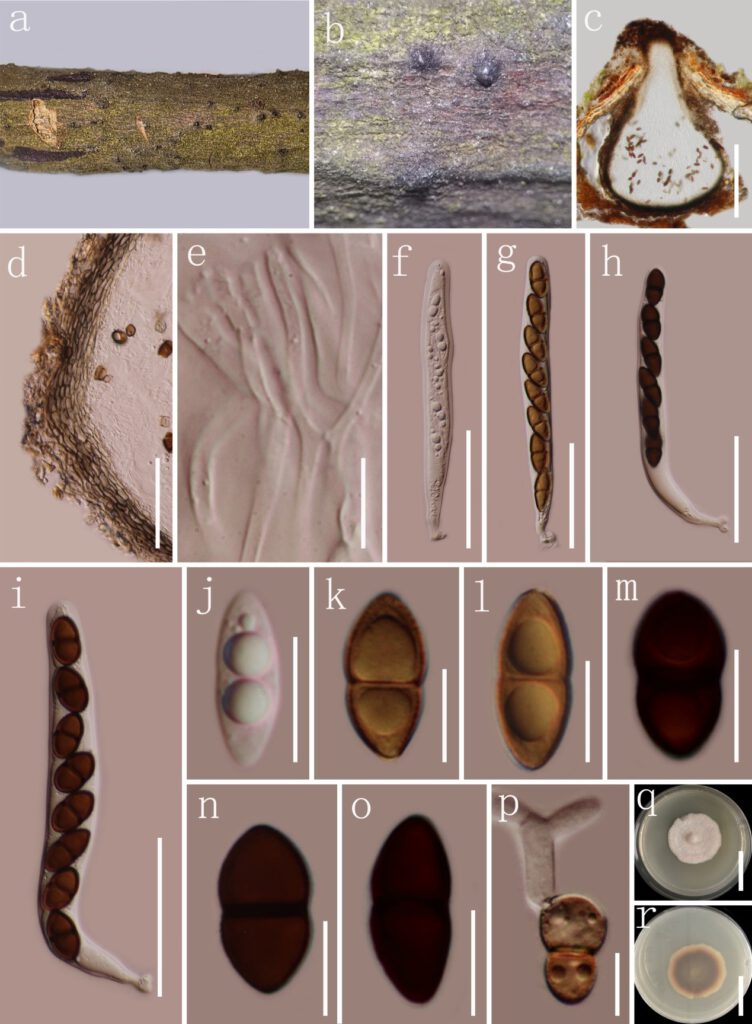Chromolaenicola sapindus G.C. Ren & K.D. Hyde, sp. nov. Fig. 4
MycoBank number: MB; Index Fungorum number: IF; Facesoffungi number: FoF 10704;
Etymology ‒ The name refers to the host genus “Sapindus,” from which it was isolated.
Holotype ‒ KUN-HKAS 122789
Saprobic on dead woody twigs of Sapindus rarak Candolle (Sapindaceae). Sexual morph: Ascomata 420–530 µm high × 270–350 µm diam. (x̅ = 480 × 300 µm, n = 5), immersed to erumpent, solitary or scattered, coriaceous, ampulliform or obovoid, dark brown. Ostiole central. Peridium 15–25 µm thick, 4–7 layered, comprising pale brown to brown cells of textura angularis. Hamathecium 1.5–3 µm wide, comprising cylindrical, septate, branching pseudoparaphyses, embedded in a hyaline, gelatinous matrix. Asci 125–155 × 12–16 µm (x̅ = 138 × 13 µm, n = 20), bitunicate, 8-spored, cylindrical-clavate, straight, slightly curved at the end, apically rounded, pedicellate. Ascospores 16–23 × 6.5–9.5 µm (x̅ = 18.9 × 8 µm, n = 30), overlapping 1-seriate, ellipsoidal, initially hyaline to pale brown and aseptate, becoming reddish-brown to brown and 1-septate at maturity, slightly constricted at the central septum, guttulate, thick-walled, smooth, without a gelatinous sheath. Asexual morph: Undetermined.
Culture characteristics ‒ Colonies on PDA, reaching 20–30 mm diam. at 14 days at room temperature (25–30 ℃), superficial, circular, umbonate at the center, with dense mycelia, smooth, downy, velvety, fimbriate, white; reverse white at the margin, dark brown at the center.
Known distribution ‒ Sapindus rarak (China).
Material examined ‒ Chian, Yunnan Province, Lancang, Lahu Autonomous Prefecture, Hani (22°24.381’N, 100°06.647’E, elevation 900 m), on dead woody twigs of Sapindus rarak, 23 March 2020, G.C. Ren, GY32 (KUN-HKAS 122789, holotype), ex-type culture KUMCC 21-0564.
Notes ‒ Chromolaenicola sapindus is introduced as a new species based on its distinct morphology and the phylogenetic results of a combined SSU, LSU, ITS, and tef1-α dataset. Chromolaenicola sapindus clusters with other Chromolaenicola species with bootstrap support (84 % ML; Fig. 1). Our species can be distinguished from Chromolaenicola nanensis and C. thailandensis in having overlapping 1-seriate, 1-septate, guttulate ascospores, whereas C. nanensis and C. thailandensis have uni-seriate, 3-transversely septate ascospores with 1-vertical septum when mature (Mapook et al. 2020). Other Chromolaenicola species (viz. C. chiangraiensis, C. clematidis, C. lampangensis, and C. siamensis) are only known from its asexual morph (Jayasiri et al. 2019, Mapook et al. 2020, Phukhamsakda et al. 2020), we also did not obtain the asexual morph from Chromolaenicola sapindus, therefore, the morphological comparison between our new species and other Chromolaenicola species are not possible. However, based on the phylogenetic distinctiveness, Chromolaenicola sapindus is introduced as a new species distinct from C. chiangraiensis, C. clematidis, C. lampangensis, and C. siamensis.

Figure 4 ‒ Chromolaenicola sapindus (KUN-HKAS 122789, holotype). a, b Appearance of ascomata on host substrate. c Section of ascoma. d Peridium. e Hamathecium. f‒i Asci. j‒o Ascospores. p Germinated ascospore. q, r Culture characters on PDA (q = from above, r = from below). Scale bars: c = 200 μm, d, f‒i = 50 μm, e, j‒p = 10 μm, q, r = 30 mm.
